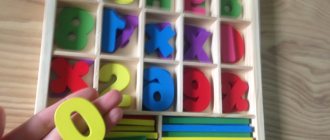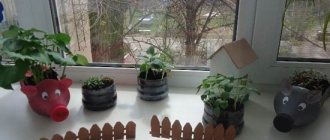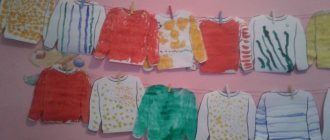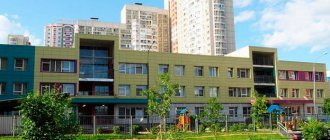Let's decide together
Can't enroll your child in kindergarten? Would you like to tell us about the teachers? Do you know how to improve your diet and exercise?
Municipal budgetary preschool educational institution, kindergarten of general developmental type No. 11 “Firefly” of the Municipal Entity Timashevsky District (MBDOU d/s No. 11) was opened in 1966.
If there is an island of love, joy, and happiness on Earth, then this is MBDOU d/s No. 11 “Firefly”. Our preschool educational institution is a living organism that breathes, feels, and rejoices. We try to penetrate every child's heart, instill in it joy, love, kindness. Preschool educational institutions are parents. They are the main assistants in our work and we are very grateful to them for this. Preschool educational institutions are employees. The most hardworking, creative people who can do everything, who care about everything with their souls, who love children. A preschool is a big family. And like any friendly family, we have our own traditions. If you want your baby to feel comfortable, to develop in accordance with his capabilities and abilities, come to us at the Firefly kindergarten.
The preschool educational institution operates in accordance with the Federal Law “On Education in the Russian Federation”. A license was issued for the right to carry out educational activities under educational programs dated March 12, 2013 No. 05353. The preschool educational institution has a license to carry out medical activities dated December 5, 2012 No. LO-23-01-005240.
The preschool educational institution ensures a high level of development of preschool children in accordance with their age and individual characteristics. Contributes to the preservation of physical and mental health, intellectual, artistic and aesthetic, social and moral development, emotional comfort of the child and his socialization.
The preschool educational institution works according to the “Basic general educational program of preschool education.”
In addition to the basic forms, teachers use new methods, technologies, and partial programs in their work:
- “Education of ecological culture among preschool children” (S.N. Nikolaeva)
“Fundamentals of the safety of preschool children” (R.B. Sterkina,)
MAIN TASKS OF EDUCATION AND TRAINING IN KINDERGARTEN:
- protecting the lives and strengthening the physical and mental health of children;
- ensuring the intellectual, personal and physical development of the child;
- introducing children to universal human values;
- interaction with the family to ensure the full development of the child.
PRIORITY DIRECTIONS:
- protecting the lives and strengthening the physical and mental health of children
- artistic and aesthetic education of children;
- interaction with the family to ensure the full development of the child.
The teachers will make sure that your child becomes independent, sociable, active, inquisitive, learns to think, develops his creative abilities, joins the world of art, and learns to create his own artistic creations; musical director L.E. Chernyavskaya will reveal the talents of your baby and he will become a real little artist; work on moral and patriotic education is carried out, skills and abilities in visual arts are improved, taking into account the age characteristics of children. Work is underway on environmental education in all groups, there is an environmental classroom “Ladybug” in which senior students conduct experiments and experiments, based on the developments of the programs “Young Ecologist” by S.N. Nikolaeva and “Our Home is Nature” by N.A. Ryzhova. Children develop a conscious attitude towards natural phenomena, towards themselves and their health. At the preschool educational institution a complex of health-improving and educational activities is carried out, the basis of which is motor activity, these are: physical education classes; physical education and health work during the day (morning exercises, physical education minutes, outdoor games and physical exercises, hardening activities, gymnastics after sleep, “health paths”); active recreation (physical education and holidays, health days, vacations); health services: phytoncidotherapy.
We provide additional development of children’s individual abilities in the “Bell” - vocal circle.
Pedagogical principles of the team:
We raise friendly, cheerful and resourceful people. We warm you with affection, warmth, care. We develop healthy, strong, dexterous people. We sow reasonable, good, eternal things.
Every child in our garden is a clear star. And this star shines brighter because she knows that she is loved and valued, knows that she will not be abandoned, but will be helped to achieve perfection.
Dear mothers and fathers, grandparents!
We are glad to welcome you to our website!
Why did we open our website on the Internet?
In order to tell more about the preschool institution, which has become a second home for us, about the kind and creative employees who give a piece of their soul and warmth to our dear students, as well as about the children themselves, whose upbringing and education we consider the most important activity. We strive to ensure that the preschool educational institution is for everyone who visits it a home in which comfort, coziness and kindness reign, where music and sonorous children's laughter are heard, a home to which they come with joy.
On this website you can get all the necessary information about the life of our kindergarten.
You can find out information about how we live. We will talk about past events and significant dates. You can look at our photo album and learn from us some experience in conducting classes and consultations.
- In the “Guest Book” section you can contact us and leave wishes and comments on the work of the preschool educational institution in general, as well as get acquainted with the opinions of other parents;
- The “Kindergarten Events” and “News” sections contain notes of classes and events conducted by our teachers;
- The “Garden Tour” section contains photographic materials of the territory of the preschool educational institution, interesting events held in the preschool educational institution, etc.;
- In the “Information for Parents” section you will find a lot of interesting things: games, poems, songs, riddles and much more;
- In the “Recommendations from Experts” section you can find consultations for educators and parents.
We hope that our site will be useful to both parents of pupils of our preschool educational institution and many others. If you have questions regarding MBDOU d/s 11, you can ask them to our email address.
We are waiting for you at:
Krasnodar region, Timashevsk microdistrict. Sugar factory 8.
tel./fax: 8 (86130) 5-35-77
Sincerely, Head of MBDOU d/s No. 11 Avramenko Tatyana Andreevna
Cognitive and research project “Invisible Air” in the senior group.
Educator: Take a plastic bag. What's in it?
Children: It's empty.
Educator: It can be folded several times. Look how thin he is. Now we fill the bag with air and twist it. The bag is full of air, it looks like a pillow. The air took up all the space in the bag. Now let's untie the bag and let the air out of it. The package became thin again. Why?
Children: There is no air in it.
Educator: Look, Kuzya! Conclusion: the air is transparent, to see it, you need to catch it. And we were able to do it! We caught the air and locked it in a bag, and then released it.
Kuzya: This bag reminded me of something! In the summer I saw people using such “locked” air! On the river! It looked like it was an air mattress! I also saw children wearing lifeguards and even a lifebuoy!
Educator: Of course, Kuzya! After all, air is lighter than water! And if there is air inside the mattress, then, of course, it floats!
Kuzya: So, if there is air inside something, it will float? Guys, help me sort out the toys: which ones will float and which ones won’t? Where did the air hide?
Didactic game “Where is the air hidden?”
(children take turns taking toys from Cousin’s chest and laying them out on 2 trays)
Educator: Well done, guys! Help Kuza! Now you know, Kuzya, that objects with air inside will float. But be careful, if water gets in and air is pushed out, the item may sink.
Kuzya: Now I know: inside objects, where it seems empty, there is air hidden there. But I wonder, is there air inside a person?
Educator: What do you think, guys? Let's check?
Experiment 2. Blow into a tube placed in a glass of water.
Educator: Blow into a tube placed in a glass of water. What's happening?
Children: Bubbles come out.
Educator: You see! Conclusion: this means there is air inside us. We blow into the tube and he comes out. But in order to blow more, we first inhale new air, and then exhale through the tube and we get bubbles. Guys, what other bubbles can you blow?
Children: Soapy.
Educator: Let's blow soap bubbles too.
F/m “Soap Bubbles” (to music)
Educator: Kuzya, what do you think is inside the soap bubbles?
Kuzya: Of course, soap!
Educator: Guys, is Kuzya right? Why? Of course, each bubble contains air inside. This soap film is filled with air and comes off the loop. Lungs filled with air bubbles float in the air.
Kuzya: I see! You exhale. It means it is inside you. But how does it get to you? Through the nose?
Educator: Of course! All people breathe through their nose. Guys, let's show Kuza how our noses breathe. When we simply inhale and exhale air, do we see it?
Summary of the open lesson “Air is invisible”
MKOU Toguchinsky district "Bugotakskaya secondary school"
Educator: Kazantseva Anna Yurievna
Summary of an open lesson in a mixed-age group “Air is invisible”
Integration of educational areas:
“Cognitive development”, “Speech development”, “Socio-communicative development”, “Physical development”.
Target:
Systematize children's knowledge about the properties of air, develop speech and cognitive activity, in the process of experimentation.
Tasks:
.
Help enrich and consolidate children's knowledge about the properties of air.
.
Expand children's understanding of the importance of air in human life.
.
Develop the ability to establish cause-and-effect relationships based on basic experimentation and draw conclusions.
.
Cultivate interest in research activities.
.
Introduce children to an unconventional
air painting technique - blotography
.
.
Activate speech activity.
.
Strengthen and expand children's vocabulary.
.
Develop the ability to independently solve a given problem.
.
Foster friendly relationships between children.
Materials and equipment:
plastic bags, toothpicks, paper fans, cups of water, cocktail straws, identification cards, containers with crushed foods (orange, garlic, onions), napkins, blindfolds according to the number of children, aprons according to the number of children, balloons, caps from felt-tip pens, audio recording, red and green signal cards, brushes, gouache pre-diluted with water, a sheet of paper.
Progress of educational activities:
Educator
: Guys, guests came to our lesson today. Let's say hello. (Greetings to the children).
(Children hold hands and stand in a circle.)
Let's join hands, friends!
Let's smile at each other.
We wish everyone well,
And let's say hello together!
Educator:
children, do you want me to tell you an amazing story? You already know that there are oceans on planet Earth. But there is another invisible ocean. We can dive into it, swim, and stay dry. What kind of ocean is this, don’t you know? Then guess the riddle: It goes through the nose into the chest and goes back on its way. It is invisible, but still we cannot live without it (Air)
Educator:
Well done boys. Do you think there is air in the kindergarten premises? (Children's answers).
Educator:
Today we will talk about air like real scientists - researchers. Scientists work in a room with many experimental instruments, but what is this room called? (Children's answers). That's right guys, laboratory. Today I organized a small laboratory for you in the group. Let's go to our laboratory to conduct experiments. We must be in special clothing, wear aprons. In the laboratory, certain rules must be followed:
. Maintain silence and do not interrupt each other.
. Do not taste the contents of the vessels.
. Do not touch anything on the tables without the permission of the supervisor.
. We listen very carefully.
. Work carefully.
Educator: guys, how can you catch air? (Children's answers).
EXPERIENCE No. 1.
“How to catch air?”
Educator
: Take plastic bags from the table and try to catch the air. “One, two, three, catch the air,” and we’ll twist the bags. What happened to the packages? (swollen). What's in them? (air).What is it like? (transparent). Do you see him? (No). Can you feel it? (No).
Educator:
Fine! Let's check. Take a sharp stick and carefully pierce the bag. Bring it to your face and press it with your hands. What do you feel? (a stream of air).
Educator
: How else can you feel the air? (children's answers).
Guys, there is a fan on the table, take it in your hands and wave it towards yourself. What do you feel? (breeze).
CONCLUSION
: You can feel the air.
Educator
: Do you know how you can see air? (children's answers).
EXPERIENCE No. 2.
"We see air"
Educator
: you need to take a straw, put one end in water, and blow on the other. (children inhale air and exhale into a tube). What do you see? (air bubbles). Blow into the tube strongly, and then weakly. What changed? (children's answers). In both cases were there the same number of bubbles? (No). Why? (children's answers).
CONCLUSION
: air mono see. When we exhale a lot and forcefully, there are a lot of bubbles. When we exhale less and weakly, there are few bubbles. Using a straw and a container of water, we saw air.
Educator:
Guys, can you hear the air? How can you hear? (children's answers). If we blow into the cap of a felt-tip pen, we will hear a sound. Take the lid and blow from the edge. What do you hear? (sound of air).
Now let's inflate the balloon. What do you think can be done with a balloon to hear the air? (children's answers), (we hear the squeak of air).
CONCLUSION
: air can be heard.
Physical education lesson: Invisible air, (hands up right and left) Go out for a walk! (“name”) Invisible air, (hands up right and left) How to catch you? (Clapping hands in different places) If I run quickly into the field, (they run in place) I’ll find clean, pure air! (Rub their hands) If I walk through the forest with my grandfather, (steps in place) I will find the most healthy air! (Hands crossed to shoulders) If I go to the mountains with my dad, (stretch up on tiptoes) I will find the most crystalline air! (“flashlights”)
Educator:
can you smell the air? (children's answers).
EXPERIENCE No. 3.
"Know by smell"
Educator: the air itself has no smell, but it can carry odors. By the smell, we can guess what our mother prepared for us in the kitchen. I invite each of you to feel the aromas (orange, onion, garlic) with your eyes closed. (Children take turns sniffing the container with the smell). You did great. Well done.
CONCLUSION:
clean air does not smell of anything, it smells only of the one whose smell is currently spreading.
Educator:
guys, do you think air has weight? (children's answers). We'll check this now. Are two balloons hanging on a wooden stick at the same level, that is, do they have the same weight? (children's answers), (Yes). The teacher pierced one balloon with a toothpick and it burst, that is, the air came out, it became lighter (higher than a balloon filled with air).
CONCLUSION:
air has weight.
Educator:
Guys, you can draw with air. This technique is called blotography. Want to try? (Yes).
Educator
: dip the brush in diluted paint and spray it onto a sheet of paper. The thicker the paint, the richer the color, but the more difficult it is to blow out. We take a tube and blow through it onto multi-colored drops of paint, they turn into blots. At the same time, the sheet of paper can be rotated - the blots turn out even more interesting! (children try to draw). Analysis of children's work.
Reflection
Educator:
Let's once again consolidate what we learned about air. I will say statements, and instead of answering you will show colored cards. A red card means no, and a green card means yes. Be careful!
-The air surrounds us on all sides. (Yes).
-The air is transparent, so we don’t see it (Yes).
-Air is heavier than water (no).
— A person can live without air (no).
-Wind is the movement of air (yes).
-Clean air has a smell (no).
Educator:
Well done guys did a great job. Guys, we did a lot of experiments today. Tell me, what experience did you like best? (children's answers). What new did you learn today? (children's answers), (blotography).
Educator:
our lesson has come to an end, you were all attentive and active. Children are given balloons as a gift.






